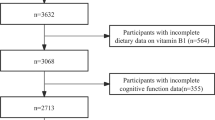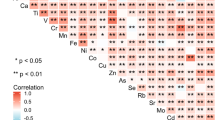Abstract
Epidemiological evidence on serum zinc and copper and cognitive impairment in older adults are not consistent. Results on serum zinc and copper and cognitive impairment in older adults from the National Health and Nutrition Examination Survey (NHANES) have not been reported. Data on serum zinc and copper and cognitive impairment from individuals ≥ 60 years of age were obtained from the 2011–2014 NHANES. Serum zinc and copper concentrations were determined with inductively coupled plasma dynamic reaction cell mass spectrometry. Cognitive impairment was assessed with four cognitive tests: the Digit Symbol Substitution Test (DSST), the Animal Fluency (AF), the Consortium to Establish a Registry for Alzheimer’s Disease Delayed Recall (CERAD-DR), and the Word Learning (CERAD-WL) tests. Compared with the lowest tertile of serum copper, the multivariate-adjusted odds ratios of scoring low on the AF were 0.86 (0.44–1.68) in tertile 2 and 0.46 (0.25–0.82) in tertile 3, and the inverse association was also found in women. No association was found between serum copper and the DSST, CERAD-DR, and CRAD-WL, respectively. Compared with the lowest tertile of serum zinc, the multivariate-adjusted odds ratios of scoring low on the DSST were 0.83 (0.37–1.90) in tertile 2 and 0.42 (0.22–0.80) in tertile 3, and the inverse association was also found in men. No association was found between serum zinc and the AF, CERAD-DR, and CRAD-WL, respectively. In conclusion, serum copper and zinc were associated with certain cognitive performance tests among older adults, and the causality deserves to be confirmed further.
Similar content being viewed by others
Data Availability
The datasets generated during and/or analyzed during the current study are available in the NHANES: https://www.cdc.gov/nchs/nhanes/.
References
Prince M, Bryce R, Albanese E et al (2013) The global prevalence of dementia: a systematic review and metaanalysis. Alzheimers Dement 9(63–75):e62
Owens DK, Davidson KW, Krist AH et al (2020) Screening for Cognitive Impairment in Older Adults: US Preventive Services Task Force Recommendation Statement. JAMA 323:757–763
Ward A, Arrighi HM, Michels S et al (2012) Mild cognitive impairment: disparity of incidence and prevalence estimates. Alzheimers Dement 8:14–21
Jomova K, Valko M (2011) Advances in metal-induced oxidative stress and human disease. Toxicology 283:65–87
Singh A, Kukreti R, Saso L et al (2019) Oxidative stress: a key modulator in neurodegenerative diseases. Molecules 24(8):1583. https://doi.org/10.3390/molecules24081583
Squitti R, Mendez A, Ricordi C et al (2019) Copper in glucose intolerance, cognitive decline, and Alzheimer disease. Alzheimer Dis Assoc Disord 33:77–85
Hancock SM, Finkelstein DI, Adlard PA (2014) Glia and zinc in ageing and Alzheimer’s disease: a mechanism for cognitive decline? Front Aging Neurosci 6:137
Warthon-Medina M, Moran VH, Stammers AL et al (2015) Zinc intake, status and indices of cognitive function in adults and children: a systematic review and meta-analysis. Eur J Clin Nutr 69:649–661
Li S, Sun W, Zhang D (2019) Association of zinc, iron, copper, and selenium intakes with low cognitive performance in older adults: a cross-sectional study from National Health and Nutrition Examination Survey (NHANES). J Alzheimers Dis 72:1145–1157
Socha K, Klimiuk K, Naliwajko SK et al (2021) Dietary habits, selenium, copper, zinc and total antioxidant status in serum in relation to cognitive functions of patients with Alzheimer’s disease. Nutrients 13(2):287. https://doi.org/10.3390/nu13020287
Bailey RL, Jun S, Murphy L et al (2020) High folic acid or folate combined with low vitamin B-12 status: potential but inconsistent association with cognitive function in a nationally representative cross-sectional sample of US older adults participating in the NHANES. Am J Clin Nutr 112:1547–1557
Meng H, Wang Y, Zhou F et al (2021) Reduced serum zinc ion concentration is associated with coronary heart disease. Biol Trace Elem Res. https://doi.org/10.1007/s12011-020-02551-8
Vaghari-Tabari M, Jafari-Gharabaghlou D, Sadeghsoltani F et al (2020) Zinc and selenium in inflammatory bowel disease: trace elements with key roles? Biol Trace Elem Res. https://doi.org/10.1007/s12011-020-02444-w
Liu Y, Zheng Y, Wang L et al (2020) Lower levels of blood zinc associated with intradialytic hypertension in maintenance hemodialysis patients. Biol Trace Elem Res. https://doi.org/10.1007/s12011-020-02385-4
Tok A, Ozer A, Baylan FA et al (2021) Copper/zinc ratio can be a marker to diagnose ectopic pregnancy and is associated with the oxidative stress status of ectopic pregnancy cases. Biol Trace Elem Res 199:2096–2103
Mahmoud HM, Ali AF, Al-Timimi DJ (2021) Relationship between zinc status and DNA oxidative damage in patients with type 2 diabetes mellitus. Biol Trace Elem Res 199:1276–1279
Chen T, Zhang H, Zhang Y et al (2021) Association of circulating and aortic zinc and copper levels with clinical abdominal aortic aneurysm: a meta-analysis. Biol Trace Elem Res 199:513–526
Ceylan MN, Akdas S, Yazihan N (2021) Is zinc an important trace element on bone-related diseases and complications? A meta-analysis and systematic review from serum level, dietary intake, and supplementation aspects. Biol Trace Elem Res 199:535–549
Bhatnagar S, Taneja S (2001) Zinc and cognitive development. Br J Nutr 85(Suppl 2):S139-145
Schrag M, Mueller C, Oyoyo U et al (2011) Iron, zinc and copper in the Alzheimer’s disease brain: a quantitative meta-analysis. Some insight on the influence of citation bias on scientific opinion. Prog Neurobiol 94:296–306
Mravunac M, Szymlek-Gay EA, Daly RM et al (2019) Greater circulating copper concentrations and copper/zinc ratios are associated with lower psychological distress, but not cognitive performance, in a sample of australian older adults. Nutrients 11(10):2503. https://doi.org/10.3390/nu11102503
Lam PK, Kritz-Silverstein D, Barrett Connor E et al (2008) Plasma trace elements and cognitive function in older men and women: the Rancho Bernardo study. J Nutr Health Aging 12:22–27
Ortega RM, Requejo AM, Andres P et al (1997) Dietary intake and cognitive function in a group of elderly people. Am J Clin Nutr 66:803–809
Gao S, Jin Y, Unverzagt FW et al (2008) Trace element levels and cognitive function in rural elderly Chinese. J Gerontol A Biol Sci Med Sci 63:635–641
Shang N, Zhang L, Wang S et al (2021) Increased aluminum and lithium and decreased zinc levels in plasma is related to cognitive impairment in workers at an aluminum factory in China: a cross-sectional study. Ecotoxicol Environ Saf 214:112110
Rivas-Garcia TE, Marcelo-Pons M, Martinez-Arnau F et al (2018) Blood zinc levels and cognitive and functional evaluation in non-demented older patients. Exp Gerontol 108:28–34
Cardoso BR, Hare DJ, Macpherson H (2020) Sex-dependent association between selenium status and cognitive performance in older adults. Eur J Nutr 60(2):1153–1159. https://doi.org/10.1007/s00394-020-02384-0
Funding
The research leading to these results received funding from Kunshan Special Fund for Social Development and Science & Technology (No.KS1545).
Author information
Authors and Affiliations
Contributions
Wenlei Song: conceptualization and data curation; Zonglin Gong: formal analysis, investigation, methodology, resources, and software; Zonglin Gong and Minjun Gu: roles/writing—original draft; Wenlei Song: writing—review and editing and supervision.
Corresponding author
Ethics declarations
Ethics Approval
The NHANES was approved by the NCHS Research Ethics Review Board.
Competing Interests
The authors declare no competing interests.
Additional information
Publisher's Note
Springer Nature remains neutral with regard to jurisdictional claims in published maps and institutional affiliations.
Rights and permissions
About this article
Cite this article
Gong, Z., Song, W. & Gu, M. Serum Copper and Zinc Concentrations and Cognitive Impairment in Older Adults Aged 60 Years and Older. Biol Trace Elem Res 200, 1495–1501 (2022). https://doi.org/10.1007/s12011-021-02765-4
Received:
Accepted:
Published:
Issue Date:
DOI: https://doi.org/10.1007/s12011-021-02765-4




